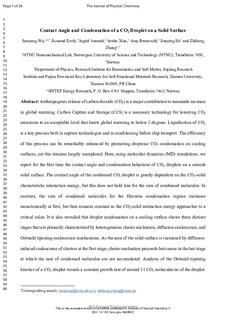| dc.contributor.author | Wu, Jianyang | |
| dc.contributor.author | Ervik, Åsmund | |
| dc.contributor.author | Snustad, Ingrid | |
| dc.contributor.author | Xiao, Senbo | |
| dc.contributor.author | Brunsvold, Amy | |
| dc.contributor.author | He, Jianying | |
| dc.contributor.author | Zhang, Zhiliang | |
| dc.date.accessioned | 2019-02-12T17:22:56Z | |
| dc.date.available | 2019-02-12T17:22:56Z | |
| dc.date.created | 2019-01-02T17:12:51Z | |
| dc.date.issued | 2019 | |
| dc.identifier.issn | 1932-7447 | |
| dc.identifier.uri | http://hdl.handle.net/11250/2585103 | |
| dc.description.abstract | Anthropogenic release of carbon dioxide (CO2) is a major contribution to manmade increase in global warming. Carbon capture and storage (CCS) is a necessary technology for lowering CO2 emissions to an acceptable level that limits global warming to below 2 °C. Liquefaction of CO2 is a key process both in capture technologies and in conditioning before ship transport. The efficiency of this process can be remarkably enhanced by promoting dropwise CO2 condensation on cooling surfaces, yet this remains largely unexplored. Here, using molecular dynamics (MD) simulations, we report for the first time the contact angle and condensation behavior of CO2 droplets on a smooth solid surface. The contact angle of the condensed CO2 droplet is greatly dependent on the CO2–solid characteristic interaction energy, but this does not hold true for the sum of condensed molecules. In contrast, the sum of condensed molecules for the filmwise condensation regime increases monotonically at first, but then remains constant as the CO2–solid interaction energy approaches a critical value. It is also revealed that droplet condensation on a cooling surface shows three distinct stages that are primarily characterized by heterogeneous cluster nucleation, diffusion–coalescence, and Ostwald ripening–coalescence mechanisms. As the area of the solid surface is increased by diffusion-induced coalescence of clusters at the first stage, cluster nucleation proceeds but ceases in the last stage at which the sum of condensed molecules is not accumulated. Analysis of the Ostwald ripening kinetics of a CO2 droplet reveals a constant growth rate of around 11 CO2 molecules/ns of the droplet. | nb_NO |
| dc.description.abstract | Contact Angle and Condensation of a CO2 Droplet on a Solid Surface | nb_NO |
| dc.language.iso | eng | nb_NO |
| dc.publisher | ACS | nb_NO |
| dc.rights | Attribution-NonCommercial-NoDerivatives 4.0 Internasjonal | * |
| dc.rights.uri | http://creativecommons.org/licenses/by-nc-nd/4.0/deed.no | * |
| dc.title | Contact Angle and Condensation of a CO2 Droplet on a Solid Surface | nb_NO |
| dc.type | Journal article | nb_NO |
| dc.type | Peer reviewed | nb_NO |
| dc.description.version | acceptedVersion | nb_NO |
| dc.source.journal | Journal of Physical Chemistry C | nb_NO |
| dc.identifier.cristin | 1648975 | |
| dc.relation.project | Notur/NorStore: NN9110K | nb_NO |
| dc.relation.project | Notur/NorStore: NN9391K | nb_NO |
| dc.relation.project | Norges forskningsråd: 254813 | nb_NO |
| cristin.unitcode | 7548,60,0,0 | |
| cristin.unitname | Gassteknologi | |
| cristin.ispublished | true | |
| cristin.fulltext | postprint | |
| cristin.qualitycode | 1 | |

